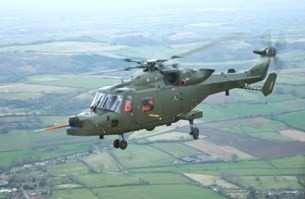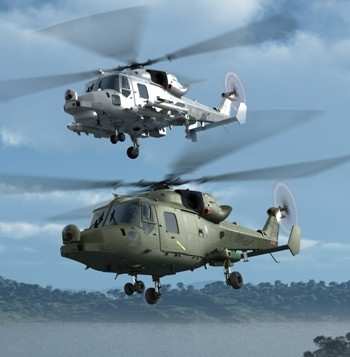Fri, Jul 23, 2010
Soon To Enter Service With The British Army And Royal Navy
The AW159 Lynx Wildcat is making its first public appearance at
the Farnborough International Air Show. The AgustaWestland
helicopter, which will be known as the Lynx Wildcat in Royal Navy
and British Army service, is a new generation multi-role helicopter
slated to replace existing Lynx aircraft. AgustaWestland announced
this week that sixty two aircraft, 34 for the Army and 28 for the
Royal Navy, will be built at it’s factory in Yeovil with
deliveries being completed in 2017.

The airframe for the first production aircraft was
delivered this month to AgustaWestland by GKN Aerospace, marking
the start of AW159 production. The production line located in
Yeovil will operate on Pulse Line principles aimed at increasing
the efficiency of the aircraft final assembly process through
reducing the time and man hours required. Once fully established,
the final assembly process, from receipt of the airframe to
delivery of the completed aircraft for acceptance testing, will
take just 3 months for each aircraft. The production line will
deliver at a rate of one AW159 Lynx Wildcat per month for the UK
MoD’s order, however, the Pulse Line will have the capacity
to more than double that rate to meet potential AW159 export
orders.
The first aircraft will be delivered at the end of 2011 with the
aircraft becoming fully operational with the Army in 2014 and the
Royal Navy in 2015. The British Army’s AW159 Lynx Wildcat
will perform a wide range of tasks on the battlefield including
reconnaissance, command and control, transportation of troops and
materiel, and the provision of force protection. The Royal Navy
variant will provide an agile maritime capability providing
anti-surface warfare capability and force protection and will
operate in support of amphibious operations and be an important
element in defending ships against surface threats. There will be a
high degree of commonality between the Army and Royal Navy
helicopters that will mean that an aircraft can switch roles
easily, principally through the changing of role equipment.

The AW159 is powered by two new generation LHTEC (a partnership
between Honeywell and Rolls-Royce) CTS800 engines, each capable of
continuously producing 1281 shp giving the aircraft exceptional hot
and high performance. The aircraft has an all up mass of 5790 kg
with a built in capability to increase that to 6250 kg. The cockpit
includes a fully integrated display system utilising four 10x8 inch
primary displays. Sensors include a nose mounted IR/TV imager with
built in laser designator and for the maritime variant the Selex
Galileo 7400E 360 degree active array radar. For self protection
the AW159 has a comprehensive integrated defensive aids suite
comprising a missile warning system, radar warning receivers and a
countermeasures dispensing system.
Additionally the Royal Navy’s AW159 Lynx Wildcats will be
capable of carrying weapons ranging from torpedoes and depth
charges to the Future Anti-Surface Guided Weapon (FASGW). The AW159
performed its maiden flight at AgustaWestland’s Yeovil
facility on November 12th last year, and since then it has
completed more than 30 hours of flight testing. Two more
helicopters will join the test fleet later this year. The AW159
program for the UK MoD was the first major project to be awarded
under the Strategic Partnering Arrangement signed by the UK
Ministry of Defence and AgustaWestland in June 2006.
More News
The Industry Continues to be Rocked By Some Questionable Operations Recent investigations and a great deal of data has resulted in ANN’s SportPlane Resource Guide’s rep>[...]
Make Sure You NEVER Miss A New Story From Aero-News Network Do you ever feel like you never see posts from a certain person or page on Facebook or Instagram? Here’s how you c>[...]
Visual Approach Slope Indicator (VASI) An airport lighting facility providing vertical visual approach slope guidance to aircraft during approach to landing by radiating a directio>[...]
Airport Marking Aids Markings used on runway and taxiway surfaces to identify a specific runway, a runway threshold, a centerline, a hold line, etc. A runway should be marked in ac>[...]
Aero Linx: The Skyhawk Association The Skyhawk Association is a non-profit organization founded by former Skyhawk Pilots which is open to anyone with an affinity for the A-4 Skyhaw>[...]
 Unfortunate... ANN/SportPlane Resource Guide Adds To Cautionary Advisories
Unfortunate... ANN/SportPlane Resource Guide Adds To Cautionary Advisories ANN FAQ: Turn On Post Notifications
ANN FAQ: Turn On Post Notifications ANN's Daily Aero-Term (04.29.24): Visual Approach Slope Indicator (VASI)
ANN's Daily Aero-Term (04.29.24): Visual Approach Slope Indicator (VASI) ANN's Daily Aero-Term (04.28.24): Airport Marking Aids
ANN's Daily Aero-Term (04.28.24): Airport Marking Aids ANN's Daily Aero-Linx (04.28.24)
ANN's Daily Aero-Linx (04.28.24)




